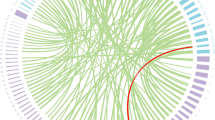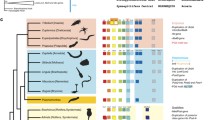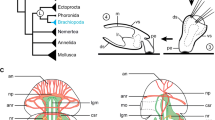Abstract
Homeobox genes have been discovered in many species. These genes are known to play a major role in specifying regional identity along the anterior-posterior axis of animals from a wide range of phyla. The products of the homeotic genes are a set of evolutionarily conserved transcription factors that control elaborate developmental processes and specify cell fates in metazoans. Crustacean, presenting a variety of body plans not encountered in any other class or phylum of the Metazoa, has been shown to possess a single set of homologous Hox genes like insect. The ancestral crustacean Hox gene complex comprised ten genes: eight homologous to the hometic Hox genes and two related to nonhomeotic genes presented within the insect Hox complexes. The crustacean in particular exhibits an abundant diversity segment specialization and tagmosis. This morphological diversity relates to the Hox genes. In crustacean body plan, different Hox genes control different segments and tagmosis.
Similar content being viewed by others
References
Abzhanov, A. and T. C. Kaufman, 1999a. Homeotic genes and the Arthropod head: Expression patterns of theLabial, Proboscipedia andDeformed genes in crustaceans and insects.Proc. Natl. Acad. Sci. USA. 96: 10224–10229.
Abzhanov, A. and T. C. Kaufman, 1999b. Novel regulation of the homeotic geneScr associated with a crustacean leg-to-maxilliped appendage transformation.Development 126(6): 1121–1128.
Abzhanov, A. and T. C. Kaufman, 2000a. Crustacean (malacostracan) Hox genes and the evolution of the arthropod trunk.Development 127(11): 2239–2249.
Abzhanov, A. and T. C. Kaufman, 2000b. Embryonic expression patterns of the Hox genes of crayfishprocambarus clarkii (crustacea, Decapoda).Evol. Dev. 2(5):271–283.
Akam, M., M. Averof, J. Castelli-Gair, R. Dawes, F. Falciani and D. ferrier, 1994. The evolving role of Hox genes in arthropods.Development (Supplement): 209–215.
Akam, M., 1995. Hox genes on the evolution of diverse body plans.Philos. Tran. R. Soc. Lond. B. Biol. Sci. 349 (1329): 313–319.
Akam, M., 2000. Arthropods: developmental diversity within a (super) phylum.Proc. Natl. Acad. Sci. USA 97(9): 4453–4456.
Affolter, M., A. Schier and W. J. Gehring, 1990. Homeodomain proteins and regulation of gene expression.Curr. Opin. Cell Biol. 2: 485–495.
Airey, D. C., H. Castillo-Juarez, G. Casella, E. J. Pollak and T. J. DeVoogd, 2000. Variation in the volume of zebrafinch song control nuclei is heritable: developmental and evolutionary implications.Proc. R. Soc. Lond. B. Biol. Sci. 267(1457): 2099–2104.
Averof, M. and M. Akam, 1993. HOM/Hox genes ofArtemia: implications for the origin of insect and crustacean body plans.Curr. Biol. 3: 73–78.
Averof, M. and M. Akam, 1995. Hox genes and the diversification of insect and crustacean body plans.Nature 376: 420–423.
Averof, M. and N. H. Patel, 1997. Crustacean appendage evolution associated with changes in Hox gene expression.Nature 388: 682–686.
Ballard, J. W., G. J. Olsen, D. P. Faith and W. A. Odgers, 1992. Evidence from 12s ribosomal RNA sequences that on chophorans are modified arthropods.Science 258: 1345–1348.
Batas, J., 1993. Control of morph genesis and different ion by Hom/Hox genes.Curr. Opin. Cell Biol. 5: 1015–1022.
Burglin, T. R., R. Arai, M. Kato and Y. Doi, 1995. In the Evolution of Homeobox Genes. The National Science Museum Foundation. Tokyo, p. 291–336.
Borre, J. L., D. V. Lavrov and W. M. Brown, 1998. Gene translocation links insects and crustaceans.Nature 392: 667–668.
Castelli-Gair, J. and M. Akam, 1995. How the Hox geneUltrabithorax specifies two different segments: the significance of spatial and temporal regulation with metameres.Development 121: 2973–2982.
Carroll, S. B., 1995. Homeotic genes and the evolution of arthropods and chordates.Nature 37: 6:479–485.
Chadwick, R. and W. McGinnis, 1987. Temporal and spatial distributions of transcripts from theDeformed gene ofDrosophila.EMBO J.G. p. 779–790.
Cook, C. E., M. L. Smith, M. J. Telford, A. Bastianello and M. Akam, 2001. Hox genes and phylogeny of the arthropods.Curr. Biol. 11: 756–763.
Copf, T., N. Rabet, S. E. Celniker and M. Averof, 2003. Posterior patterning genes and the identification of a unique body region in the brine shrimpArtemia franciscana.Development 130(24): 5915–5927.
Damen, W. G. M., M. Hausdorf, E. A. Seyfarth and D. Tautz, 1998. A conserved mode of head segmentation in arthropods revealed by the expression pattern of Hox genes in a spider.Proc. Natl. Acad. Sci. USA. 95(18): 10665–10670.
Derosar, J., K. Grenier, T. Andreeva, C. E. Cook, A. Adoutte and M. Akam, 1999. Hox genes in brachiopods and priapulids and protostome evolution.Nature 399: 772–776.
Deutsch, J. S., E. Mouchel-Vielh, 2003. Hox genes and the crustacean body plan.Bioessays 25(9): 878–887.
Dohle, W., R. A. Fortey and H. Thomas, 1997. Myriapod-insect relationships as opposed to an insect cruatacean sister group relationship.In: Arthropod Relationships. Chapman and Hall, Landon. p. 305–316.
Duncan, I., 1987. The Bithorax complex.Ann. Rev. Genet. 21: 285–319.
Garcia-Bellido, A., 1997. Homeotic and atavic mutations in insects.Amer. 17: 613–629.
Giesbrecht, W. and R. Dittler, 1931. Naturwiss ecschaften inHandworterbuchder (Fischer, Jena), p. 800–840.
Graba, Y., D. Aragnol and J. Pradel, 1997.Drosophila Hox complex downstream targets and the function of homeotigenes.Bioessays 19: 379–388.
Hughes, C. L. and T. C. Kaufman, 2002. Exploring the myriapod body plan: expression patterns of the ten Hox genes in a centipede.Development 129: 1225–1238.
Kappen, C., 2000. Analysis of a complete homeobox gene repertoire: Implications for the evolution of diversity DNAs.Proc. Natl. Acad. Sci. USA. 97 (9): 4481–4486.
Kaufman, T. C., M. A. Seeger and G. Olsen, 1989. Molecular and genetic organization of the antenna apediagene complex ofDrosophila melanogaster.Adv. Genet. 27: 309–362.
Lewis, E. B., 1978. A gene complex controlling segmentation inDrosophila.Nature 276: 565–570.
Lawrence, P. A. and G. Morata, 1983. The elements of the bithorcomplex.Cell 35: 595–601.
Lawrence, P. A., 1992. The Making of Fly. Blackwell Scientific, Oxford, p. 1–56.
Mahaffey, J. W. and T. C. Kaufman, 1987. Disribution of theSex combs reduced gene products inDrosophila melanogaster.Genetics 117: 51–60.
Mouchel-Vielh, E., C. Rigolot, J. Gibert and J. Deutsch, 1998. Molecular and body plan: The Hox Genes of cirripeds (crustacean),Mol. Phylogenet Evol. 9(3): 382–389.
Mouchel-Vielh E., M. Blin, C. Rigolot, J. S. Deutsch, 2002. Expression of a homologue of thefushitarazu (ftz) gene in a cirripede crustacean.Evol Dev. 4(2): 76–85.
Panganiban G., A. Sebring, L. Nagy, S. Carroll, 1995. The development of crustacean limbs and the evolution of arthropods.Science 270: 1363–1366.
Patel, N. H., T. B. Komberg and C. S. Goodman, 1989. Expression ofengrailed during segmentation in grass-hopper and crayfish.Development 107: 201–212.
Rogers, B. T., M. D. Peterson and T. C. Kaufman, 1997. Evolution of the insect body plan as revealed by theSex combs reduced expression pattern.Development 124(1): 149–157.
Rusch, D. B. and T. C. Kaufman, 2000. Regulation ofproboscipedia inDrosophila by Homeotic Selector Genes.Genetics 156: 183–194.
Schram, F. R., 1986. Crustacea. Oxford: Oxford University Press, p. 1–236.
Schram, F. R. and J. T. Hoeg (eds.), 1995. New Frontiers in Barnacle Evolution. Crustacean Issues 10, A. A. Balkema, Rotterdam, p. 297–312.
Telford, M. J. and R. H. Thomas, 1998. Expression of homeobox genes shows chelicerate arthropods retain their deutocerebral segment.Proc. Natl. Acad. Sci. USA. 95(18): 10671–10675.
Vachon, G., B. Cohen, C. Peifle, M. E. McGuffin, J. Botas and S. M. Cohen, 1992. Homeotic genes of the bithorax complex repress limb development in the abdomen of theDrosophila embyo through target geneDistal-les.Cell 71: 437–442.
Walossek, D., 1993. The Upper Cambrian Rehbachiella and the phylogeny of branchipoda and crustacea.Fossils and Strata 32: 1–202.
Warren, R. and S. B. Carroll, 1995. Homeotic genes and diversification of the insect body plan.Curr. Opin. Genet. Dev. 5(4): 459–465.
Author information
Authors and Affiliations
Corresponding author
Additional information
Project No. 30271035 supported by NSFC.
Rights and permissions
About this article
Cite this article
Lin, H., Zhijuan, C., Mingyu, X. et al. Hox genes and study of Hox genes in crustacean. Chin. J. Ocean. Limnol. 22, 392–398 (2004). https://doi.org/10.1007/BF02843634
Received:
Accepted:
Issue Date:
DOI: https://doi.org/10.1007/BF02843634




